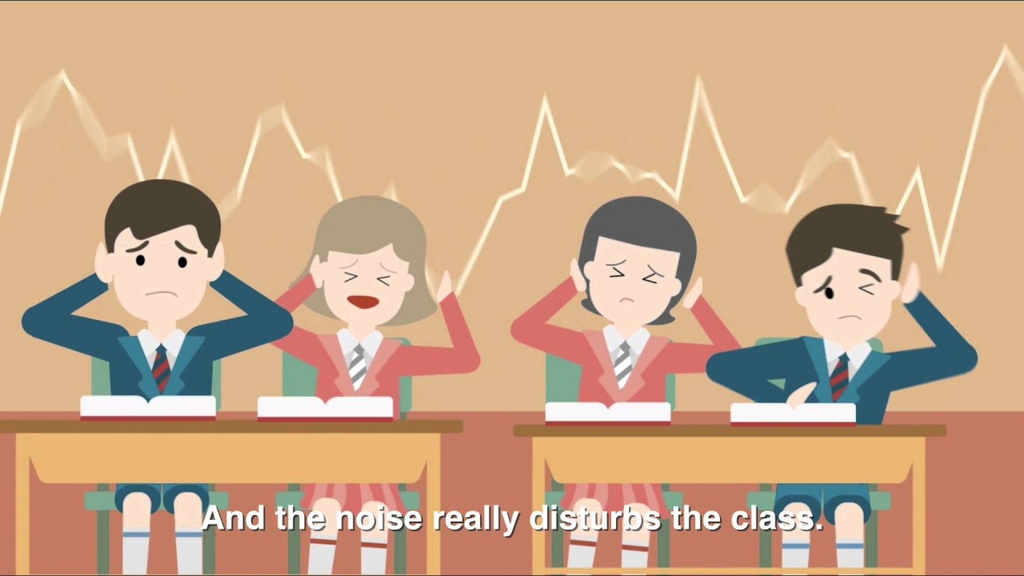Active germs in classrooms are enough to make anyone stay at home. Since kids have more daily social interaction and physical contact with one another, they are at high risk for spreading germs. While there is no way to completely eliminate the risk of exposure, there are some steps to help reduce the spread of germs in the classroom. One of the simple and most effective measure is to install an air purifier. Classroom air purifiers can help to remove contaminants from the air, eliminate viruses and bacteria. Additionally, they can also help to reduce odors and improve air quality.
When it comes to choosing air purifier for classrooms, there are a few things to consider. The size of the room is the most vital factor, as different air purifying units have different covered area capacity. Additionally, you should consider the type of filter the air purifier uses. Some air purifiers are better at removing certain contaminants, such as viruses or bacteria. You don't want students or teachers to live with severe allergies or asthma, so must look for an air purifier with filters designed to keep seasonal allergies and the flu away.
Skip and jump to choosing air purifiers for classrooms
Overall, installing an air purifier in classrooms can be a simple and effective way to help reduce the spread of germs and improve air quality.
But choosing which air purifier is best for classroom can seem complicated. In this article, we take you step by step on how to choose the perfect germs fighting machine that will keep all those good chalkboards clean and fresh without fazing out any of the students!
There are a few questions you might have before choosing the best air purifier for classroom:
- Where to put air purifiers in the classroom?
- What size air purifier for classroom is ideal?
- Which one is the best air purifier for allergies?
Where to Place an Air Purifier in a Classroom?

Portable air purifiers are often a better option than inbuilt large ventilation systems since they’re easy to clean and can be moved around. If you have the wrong type or placement of machine, then it could push infected particles from one part into another without your knowledge! A quiet but powerful air purifier might become less effective when turned down too low - so some teachers benefit greatly by having two medium strength purifiers instead of just 1 strong setting because this allows them more control over where exactly each individual room needs attention at any given time.
What Size Air Purifier for School Classrooms is Ideal?

Air purifiers can be classified by size, with small being good for rooms measuring less than 300 sq ft. Medium-sized units are ideal in common areas that measure between 300 - 600 square feet while large models may work best to maintain classrooms larger than 1200 sqft., but all three types will always provide a clean environment. It's important when purchasing an air cleaner not just go based off dimensions alone because each type requires specific maintenance requirements like plumbing connections or electricity supply junctions which determine how much space they take up
Which One is The Best Air Purifier for Allergies?

With many different type of air purifying units in the market, it can be hard to decide which one is best. You might think that allergy would only affect those with sensitive respiratory systems but poor indoor quality could also give headache-inducing symptoms and ultimately impact students or teachers. To help combat these issues we recommend choosing one that fits best to classroom needs - some schools might need medical grade filtration while some prefer lower maintenance models since they'll likely use them indoors most often (though both work equally well). There are a number of different types and technologies when it comes to air purifiers.
- HEPA Based Air Purifiers
- Activated Carbon Technology (ACT) Purifiers
- UV Air Purifiers
HEPA Based Air Purifiers
High-efficiency particulate air (HEPA) units have been around for many years because they're able to capture mold spores as well as bacteria which can lead to harmful diseases like tuberculosis or plague in addition to other chemicals that may be present throughout their environment such things you would find on furniture etc. This means less risk from exposure when using this type of equipment compared to sterilization methods where ozone is created during its operation.
Activated Carbon Technology (ACT) Purifiers
In order to help people with Multiple Chemical Sensitivity (MCS), who are sensitive or adverse to reactions from carpeting and furniture polish chemicals found in play areas or activity rooms in school, air purifiers that use activated carbon filters will absorb these toxins. This makes the environment much more breathable for those struggling asthma-wise as well!
UV Air Purifiers
With a UV air purifier, you can say goodbye to unhealthy odors and harmful chemicals in classroom! The device will convert molecules of pesky atmosphere into ozone or hydroxyl which then react with any deposited pollutants breaking them down safely so that students don't have issues like bad smells too.
Classroom Air Purifiers: 6 Tips to Pick the Perfect One
1. Identify Classroom Dimensions

You won't consider an air purifier that will take up too much space. Make sure to understand what kind of classroom or area needs air purification before making a purchase decision. Since the size of classrooms can have a big impact on which air purifier is best. First, estimate the floor area in sq. ft or meters, and multiply this number by height to get total volume. Secondly, check the data page of the website before purchasing to ensure the dimensions are accurate and the power is adequate.
2. Choose Optimal ACH & CADR Rated Air Purifier

The cleaner the environment is, the healthier the students will tend to be. That's why it is crucial to have a high-quality air purifier in place so the students and teachers can breathe easy and enjoy all of those healthy benefits! Air quality rating or CADR measures how well an individual unit removes smoke, dust and pollen from the surface. While ACH (air changes per hour) measures the air purifier efficiency. Although you don't have to calculate this yourself since most manufacturers define ACH and CADR for their devices according to different size rooms, offices or classrooms in terms of how many people are using them at once.
3. Know Replacement & Maintenance Cost

The cost of replacement filters can vary depending on the type of air purifiers. For example, HEPA air filters need replacement after every six months, carbon filter-based air purifiers need filter replacement every six to twelve months, hydroxyl technology-based air purifiers need replacement in about 3 to 4 months. In addition to the cost of replacement filters, you’ll also need to factor in the cost of regular maintenance. Depending on how frequently you need to clean the air purifier unit or replace its filters, you’ll have to put in extra maintenance effort and bear an overhead cost.
4. Consider Noise Level and Energy Consumption
When choosing an air purifier for classrooms, it's important to consider the noise level. You don't want a unit that's so loud it will be disruptive to students and teachers. Look for a unit with a noise level of 40-50 decibels. This will ensure that the unit remains quiet while maintaining efficient air filtration. Another important consideration is energy consumption. Air purifiers use significantly less energy than other devices, such as a computer or air conditioner. So ultimately the classrooms will be healthier while saving money on energy bills.
5. Go for a Portable Air Purifier
![]()
Air purifier comes in different shapes and sizes, but the best ones have one thing in common: they're portable. That means you can easily plug them in and place them wherever you need them, without having to make any costly upgrades to entire school HVAC system. And since they're so easy to use, you'll actually use them every day. Just set it up and forget about the rest, knowing that they're quietly working to clean the air in the entire classroom. Plus, they're very low maintenance. Just dust them off every now and then and you're good to go. So if you're looking for an easy way to improve the air quality in your classrooms, a portable air purifier is worth considering.
6. Must Have Easy to Operate Functions

Air purifiers with the latest technology are likely to have smart operating functions that help teachers or students to easily operate without any hassle. When you invest in a brand new air purifier, classrooms are sure to become much more germ-free. Students will have fewer problems with allergies and respiratory illnesses because of dirt particles that are present in the air. Also, it’s difficult for teachers to use old models with complicated functions.
Why Do Classrooms Need Air Purifiers?
According to the Centers for Disease Control and Prevention, more than 50% of all classrooms in the USA have at least one person with asthma. Air purifiers are an important part of keeping your environment clean and healthy. They can help reduce asthma symptoms and improve air quality in classrooms. Getting air purifiers that are designed specifically for classrooms, easy to use and maintain are highly recommended. Here are 3 core reasons why classrooms must have air purifiers:
Classrooms are Compact & Crowded: What's the perfect environment for spreading viruses and bacteria? A small packed area with a bunch of students and teachers! obviously. This not only causes low quality air, but such an atmosphere is ideal territory to let germs spread.
Teachers & Students Are Sensitive to Pollen: Bad air quality can have a serious impact on students or staff who are more sensitive to pollution and air-borne diseases. That’s why it is advisable to have improved air quality in classrooms, so everyone can breathe easier and feel better.
Poorly Ventilated Classrooms: To create a perfect learning environment, classrooms should have proper ventilation. If they don't and air pollution becomes excessive due to lack of circulation or dirty filters on appliances such as Fans then you'll notice an increase in symptoms like headaches discomfort shortness breaths which can lead one down a path towards chronic illness. Though it becomes vital to use air purifying devices to help make classrooms safe with fresh filtered breaths every day.
Keep Classrooms Safe with WellisAir

WellisAir Purifier's patented OH radical technology replicates Mother Nature to provide a constant stream of hydroxyls that destroy contaminants on both surfaces & air, and help people breathe clean air. WellisAir has been a staple in schools for years, and with good reason. It's equipped with hydroxyls that can destroy contaminants on both surfaces & inside classrooms - helping students stay safe from harm no matter where life takes place! WellisAir is the most efficient and cost-effective air purifier for classrooms. It is designed with an aim to provide filtration that's not only good enough in removing harmful particles but also safe, making it suitable even when occupied by small children or those who suffer from allergies!



